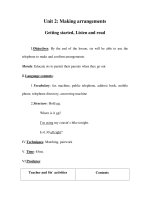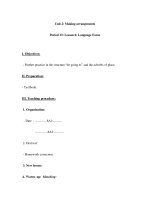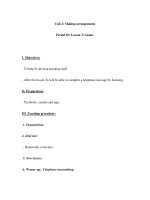Unit 2. Making arrangements
Bạn đang xem bản rút gọn của tài liệu. Xem và tải ngay bản đầy đủ của tài liệu tại đây (141.29 KB, 5 trang )
<span class='text_page_counter'>(1)</span><div class='page_container' data-page=1>
<b>Period: 7</b>
<b>UNIT 2: MAKING ARRANGEMENTS</b>
<b>GETTING STARTED & LISTEN AND READ</b>
<b>I. OBJECTIVES </b>
<i><b>1. Knowledge, Skills, Attitude: </b></i>
<i><b>a. Knowledge:</b></i>
By the end of the lesson, Ss will use the telephone to make and confirm arrangements
<i><b>- Grammar: be going to + inf, - adverbs of place (at, from, … )</b></i>
<i><b>- Vocabulary: Mobile phone, fax machine, telephone directory, answering machine, address book, </b></i>
public telephone, making arrangements
<b>b. Skills: Listening, speaking, reading and writing.</b>
<b>c. Attitude: - Students how to answer the telephone.</b>
<i><b>2. Capacity is formed and developed for students</b></i>
- Self-learning capability.
- Communicative competence
- Cooperation capacity
<b>II. Preparation</b>
<i><b>1. Teacher: - Lesson plane, book, color chalks, pictures, MP3</b></i>
<i><b>2. Students: Prepare getting … read, do exercise on part listen then read; books, notebooks, pen, …</b></i>
<b>III. Students’ activities</b>
<i><b>1. Warm up (5’)</b></i>
<b>Teacher’s and Ss’ activities</b> <b>Content</b>
- T presents the pictures
- Ss to match each object (pictures on page 18 ) with
its name
- T gives the definition of these objects on a poster
and ask Ss to match the object with its definition
<b>I. Getting started:</b>
<i>* Ss know some public information and when </i>
<i>use them</i>
<i>“<b>Questions”</b></i>
- What’s this?
- When do you use it?
* Matching:
Answers:
a. an answering machine
b. a mobile phone
c. a fax machine
d. a telephone directory
e. a public telephone
f. an address book
<i><b>2. Knowledge formation activities (32’)</b></i>
<b>Teacher’s and Ss’ activities</b> <b>Content</b>
T introduces the situation “Hoa and Nga are talking
on the phone. They are talking about going to see a
movie”
- T turns on the tape.
- Ss listen to the tape.
- T explains new words/ phrases
-T asks Ss to practice the dialogue in front of the
class
- Ss work in pair
- T asks Ss to practice before class.
- One S asks and answers in front of class.
<b>II. Listen and read.</b>
<i>* Ss will use the telephone to make and confirm </i>
<i>arrangements</i>
<i><b>1. Practice the dialogue with a partner.</b></i>
- arrange(v) – arrangement(n)
- a bit far form
- T gives some questions
- Ss answer
- T gives feedback
</div>
<span class='text_page_counter'>(2)</span><div class='page_container' data-page=2>
<b>Open prediction : a. Who make the call?</b>
b. Who introduced herself?
c. Who invited the other to the movies?d. Who
arranged a meeting place?
e. Who arranged the time?
f. Who agreed to the time?
ª Answer (p/19)
a. Nga b. Nga c. Nga
d. Nga e. Hoa f. Nga
<i><b>3. Consolidation (4’)</b></i>
Ss make the arrangements they’ve made.
<i><b>4. Its operations (4’)</b></i>
- T asks ss some comprehension questions
about the dialogue.
- T asks Ss to play the roles of two Ss who are
talking on the phone making arrangement and
answer the questions.
- Ss: pair work
<b>Questions</b>
1. What’s Hoa’s telephone number?
2. Which movie are they going to see? Where?
3. How is Hoa going to see the movies?
4. Where are they going to meet? What time?
<i><b>5. Apply</b></i>
<b>IV. Experience:</b>
………
………
………
<b>Period: 8</b>
<b>UNIT 2: MAKING ARRANGEMENTS</b>
<b>SPEAK AND LISTEN</b>
<b>I. OBJECTIVES </b>
<i><b>1. Knowledge, Skills, Attitude: </b></i>
<i><b>a. Knowledge: By the end of the lesson, students will be able to use the telephone to make and</b></i>
confirm arrangements
<i><b>- Grammar: -Would you like...? - Can I (speak)...? </b></i>
- Is (the time) ok? / All right? - Let’s (meet).../see you...
<i><b>- Vocabulary: </b></i>
<b>b. Skills: Listening, speaking, reading and writing.</b>
<b>c. Attitude:</b>
<i><b>2. Capacity is formed and developed for students</b></i>
- Self-learning capability.
- Communicative competence
- Cooperation capacity
<b>II. Preparation</b>
<i><b>1. Teacher: - Lesson plane, book, color chalks, pictures, MP3</b></i>
<i><b>2. Students: Practice speaking and listen at home; books, notebooks, pen, ruler …</b></i>
<b>III. Students’ activities</b>
<i><b>1. Warm up (5’)</b></i>
<b>Teacher’s and Ss’ activities</b> <b>Content</b>
- T asks Ss to play game
- Ss give feedback
- T corrects
1. What do you say when you want to invite
someone to go?
2. Lucky number.
</div>
<span class='text_page_counter'>(3)</span><div class='page_container' data-page=3>
<i><b>2. Knowledge formation activities (36’)</b></i>
<b>Teacher’s and Ss’ activities</b> <b>Content</b>
- T asks Ss to predict
- Ss work in group
- T asks Ss to make a complete the conversation
- Ss give feedback
- T asks Ss to read in chorus (2 roles ) and then
change the role
- Ss work in pairs
- T corrects
- T asks Ss to work with their partners to complete
the dialogue
- Ss give feedback
- T corrects
- T asks Ss to practice
- Ss practice the open dialogue (pair work)
- T corrects
<b>III. SPEAK:</b>
<i>* Students will use the telephone to make </i>
<i>and confirm arrangements</i>
<i><b>1. Put the sentences below in the correct order</b></i>
<i><b>to make a complete conversation.</b></i>
1.b 2.f 3.j 4.a
5.i 6.c 7.e 8.k
9.g 10.h 11.d
<i><b>2. Complete the dialogue. Ba and Bao are</b></i>
<i><b>making arrangements to play chess. Practice</b></i>
<i><b>the dialogue with a partner. Then make similar</b></i>
<i><b>arrangements</b></i>
<i><b>Answer:</b></i>
1. May I speak to Ba please, This is Bao
2. I’m fine, thanks, and you?
3. Can you play chess tonight?
4. What about tomorrow afternoon?
5. I’ll meet you at the central chess club.
6. Is 2.00 o’clock OK?
Make similar dialogue .Using cards cues given.
1. Hoa Lu cinema / 6.30 pm / at the front gate /
by bike.
2. go swimming / 4:30 pm /Ly Tu Trong
swimming pool / by bus
3. play soccer / 1:30 p.m /Hoa Thanh stadium /
by bike
- T asks Ss to guess the message
- Ss work (pair work)
- T gives feedback
- T plays the cassette
- Ss listen to the tape twice and fill in the message,
compare with their guess.
- Ss work in pairs
- Ss answer the questions
- T gives feedback
<b>IV. LISTEN:</b>
<i>* Ss complete the information Kingston Junior </i>
<i>High School.</i>
<i><b>Answers</b></i>
Kingston Junior High School.
Date :
Time :
For : the principal
Message: Mr. Mary Nguyen wanted to see you
at 9.45 in the morning.
Telephone number :64683720942
<i><b>“Answer some questions”</b></i>
1 What’s the woman’s name?
2 Who did the woman want to see?
<i><b>3. Consolidation (4’)</b></i>
- T reminds ss of some steps to make an arrangement on the phone.
<b>IV. Experience:</b>
………
………
………
</div>
<span class='text_page_counter'>(4)</span><div class='page_container' data-page=4>
<b>UNIT 2: MAKING ARRANGEMENTS</b>
<b>READ</b>
<b>I. OBJECTIVES </b>
<i><b>1. Knowledge, Skills, Attitude: </b></i>
<i><b>a. Knowledge:</b></i> - By the end of the lesson, students will know more aboutAlexander Graham Bell.
<i><b>- Grammar: simple past tense</b></i>
<i><b>- Vocabulary: emigr</b></i>ate, deaf- mute, transmit, lead-led-led, assistant, conduct, demonstrate, device,
exhibition, countless, commercial.
<b>b. Skills: Listening, speaking, reading and writing.</b>
<b>c. Attitude: Study hard to help our country.</b>
<i><b>2. Capacity is formed and developed for students</b></i>
- Self-learning capability.
- Communicative competence
- Cooperation capacity
<b>II. Preparation</b>
<i><b>1. Teacher: - Lesson plane, book, color chalks, pictures.</b></i>
<i><b>2. Students: - Books, notebooks, pen, ruler …</b></i>
<b>III. Students’ activities</b>
<i><b>1. Warm up (5’)</b></i>
<b>Teacher’s and Ss’ activities</b> <b>Content</b>
- T lets students answer the questions by coming to
the board and write.
<i>* Possible answers:</i>
- to chat with friend .
- to make arrangement
- to call someone
- to talk to a person who live far from.
- to communicate
- to have a message
- to get information at the airport or railway
station quickly.
<i><b>2. Knowledge formation activities (32’)</b></i>
<b>Teacher’s and Ss’ activities</b> <b>Content</b>
- T introduces the content of the lesson and explains
new words
- T has students repeat the words in chorus then rub
out word by word but leave the circles. Remember to
let students repeat before and after rubbing out each
word.
- Go on until students can remember the words.
- Get students to write the words again in the correct
circles
<b>V. Read</b>
<i>* Students will know more aboutAlexander </i>
<i>Graham Bell.</i>
- (to) emigrate: (example): go to another country
to live. di cư
- deaf- mute: (explanation: a person who is unable
to hear and speak) tật vừa câm, vừa điếc
- (to) transmit: (translation)truyền phát tín hiệu
- lead-led-led( explanation: cause to go with one)
- assistant((explanation: a person who helps )
- (to) conduct: (synonym: What’s the synonym of
(to) carry out).thực hiện, tiến hành
- (to) demonstrate: (translation). biểu diễn
- device: (translation) thiết bị, dụng cụ,máy móc
- exhibition((synonym= display)
- countless: (translation) vơ số
- commercial (translation) thuộc về thương mại
- T shows the poster of T/F statements on the board
and asks students to work in pairs and guess which
statements are true and which are false.
<i><b>1. True or false? Check the boxes. Correct </b></i>
<i><b>the false sentences.</b></i>
</div>
<span class='text_page_counter'>(5)</span><div class='page_container' data-page=5>
- Ss work in pairs
- T calls some students to give the answer before class.
- Ss give the answer before class.
- T gives feedback.
Scotland
b) F He worked with deaf-mute patients in at
Boston University.
c) T.
d) F Bell and Watson introduced the telephone
in 1876.
e) F Bell experimented with ways of transmitting
speech over a long distance.
f) T
- T asks students to read the text on page 21-22 and
check their prediction.
- Students to look at the book page 22.
- T gets students to read the events of Bell's life and
put them in the correct order.
- Ss compare with their partners.
<i><b>2. Put the events in the correct order</b></i>
- Alexander Graham Bell
1. was born in Scotland
2. went to live in Canada.
3. Went to live in the United States.
4. worked with people who could neither speak
nor hear.
5. worked with Thomas Watson.
6. Successfully demonstrated his invention.
7. Invented the telephone.
<i><b>3. Consolidation (4’)</b></i>
Ss copy the events in order into their notebook.
<i><b>4. Its operations (4’)</b></i>
<i><b>Writing it up:</b></i>
- T gets students to telling a paragraph
about Bell's life, remember the
information from the text.
- T lets them read aloud before the class
and correct their pronunciation.
- Suggestion:
Alexander Graham Bell was born on March 3rd, 1847
in Scotland. He went to live in Canada and then to the
U.S.A in 1870s. He worked with deaf mutes at Boston
University and did experiments with ways of
transmitting speech over a long distance. In 1876, he
and his assistant - Thomas Watson introduced the
telephone successfully and in 1877 the first telephone
was in commercial use.
<b>IV. Experience:</b>
………
………
………
Signature
Week 3: ...
</div>
<!--links-->









